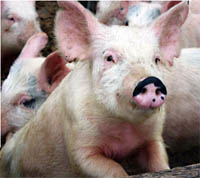Lab team wins poster award for virus research
Their work, done in collaboration with a researcher from the Richmond-based California Department of Public Health, won one of three outstanding poster awards at a Defense Threat Reduction Agency (DTRA) conference.
The three poster award winners were selected from among 588 posters that were presented at DTRA's Chemical & Biological Science & Technology Conference held recently in Orlando, Fla.
Information from the scientists' work could potentially be useful for forensic purposes, as well as determining the likelihood that a virus may jump from one species of animal to another, or from animals to human beings.
The Lab team is led by Monica Borucki, a biomedical scientist in Physical & Life Sciences, and includes Jonathan Allen and Clinton Torres, both bioinformatics scientists from Computation, and Tom Slezak, the associate Informatics program leader from Global Security. They are collaborating with Sharon Messenger of the California Department of Public Health.
"Understanding the evolution of RNA viruses is a major scientific problem that is essential for developing a better biodefense," Borucki said.
Backing up her point, Borucki noted that three-quarters of recently discovered pathogens are viral, that one to four new pathogenic viruses are discovered each year and that most of the viruses that jump to new species are viruses with genomes composed of RNA. Most of these viruses are animal viruses that "jump species" and infect humans.
At the DTRA conference, Allen presented data from preliminary experiments that involved ultra-deep Illumina sequencing on three different naturally infected samples --brain tissue from two rabid foxes that appear to be involved in a rabies host-jumping event and a nasal sample from a calf infected with bovine coronavirus.
Through the California Department of Public Health, Livermore scientists have received brain tissue samples of foxes that have apparently been bit by skunks, contracted rabies and attacked people or pets. In 2009, there was a 356 percent increase in the number of foxes contracting rabies in California, with most of these cases occurring in Humboldt County.
"We're interested in understanding how a virus changes at the population level as it adapts from one host to another," Borucki said. "We're particularly interested in this area because many diseases move from animals to people."
The researchers' ultimate goal is to determine the probability of a specific animal virus jumping from animals to humans, Borucki noted.
While many research teams conduct genomic analysis on about 300 base pairs of the 12,000-base pair rabies genome, the LLNL team has performed this analysis on 11,000 base pairs. In addition, normally 1-30 viral genome copies are used in analysis, but the Lab team relied on some 300,000 viral genome copies.
"Although the rabies virus has jumped species multiple times in the past, the event is relatively rare and whole genomic sequencing analysis has never been applied to such an event," Borucki said.
During the next year, the team plans to analyze 50 different rabies samples from a naturally occurring host-jumping event (skunks to foxes in Northern California) and 35 different bovine coronavirus samples from a laboratory-simulated host-jumping event. This work is funded by the Defense Threat Reduction Agency as part of the Transformational Medical Technologies program.
Contact
Stephen P Wampler[email protected]
925-423-3107
Related Files
DownloadTags
VirusesPhysical and Life Sciences
Threat preparedness
Biosecurity
Featured Articles









